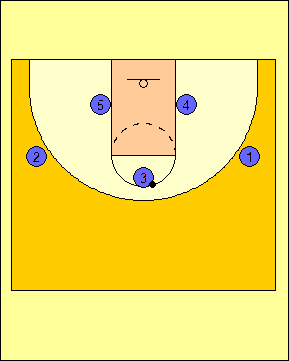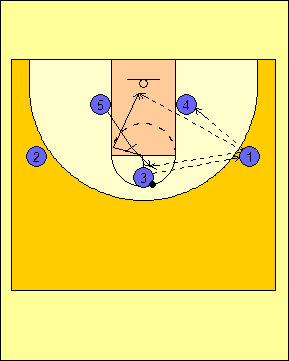|

Basketball Coaching DVD's at Championship Productions
THE 2-OUT/3-IN OFFENSE
Many coaches such as Bob Knight and Steve Alford have found it advantageous to
run an offense that is physical in nature and allows for a limited number of
ball-handlers. This offense has been the 2-Out/3-In Offense. This
offense features three big men who are all adept at handling the basketball and
are capable of making plays within the structure of the offense. This
offense also works well with two guards who are capable of hitting big perimeter
shots and facilitating the big men within the framework of the offense.
Advantages of the 2-Out/3-In Offense
First, the offense is that of a physical nature. The three big men will
set screens that will wear down the defense over the course of the game.
This will become advantageous to us late in games and might even result in some
foul troubles for defenders who are looking to match the physicality of the
offense.
Second, the offense also allows for match-up advantages for the offense.
If you are playing a team that has post players who are not very good perimeter
defenders, the post players can take advantage. The offense puts bigs on
the perimeter playing defense when they are not accustomed to such a
requirement.
Finally, the 2-Out/3-In Offense can be run from either a three-around-two look
or a four-around-one look. This gives the offense a degree of flexibility
as to whether to run with two posts in the offense or to isolate the low post.
Disadvantages of the 2-Out/3-In Offense
The first big disadvantage of the 2-Out/3-In Offense is that it requires three
big men who are skilled enough to set screens, play facing the basket, and
posting up. The offense also requires a lot of breakdown time for it to
work effectively so that the offense can become mastered.
The other disadvantage is that if you have a play-making guard, this offense
will stifle his ability to create scoring opportunities for himself. The
offense works best when the guards work as feeders and the bigs work as the
playmakers.
Finally, the offense does not lend itself well to the fast break. As with
any other offense that is dominated by as many big men as this offense requires,
the fast break is not likely to occur with any degree of frequency. Teams
that employ this offense will want to avoid getting into high-scoring games and
instead focus on wearing down the opponent with the aggressive screening action
of this offense.
Three-Around-Two Look
There are two formations from which a team can run a
2-Out/3-In Offense. The first of these is the three around two
look shown in Diagram 1. This has the three inside players occupy
both low posts and the high post. The two guards, working as
feeders, position themselves at the wings.

Diagram
1 |
There are a number of options that can be run when
the ball is passed to the wing. The first of these is to have
the ball-side low post position himself and work to get open as
shown in Diagram 2. While this is happening, the help-side low
post sets a back screen for the player in the high post. The
feeder can pass to either of the three with his looks being the
post-up, the cutter, and the screener in that order.

Diagram
2 |
Should this option not be available, another option is our screen-the-screener
option. In Diagram 3, the ball-side low post sets a cross screen for the
help-side low post. Once the cutter has come though on the cross screen,
the high post sets a down screen for the first screener.

© 2010-2017 Alan Peel Enterprises
|